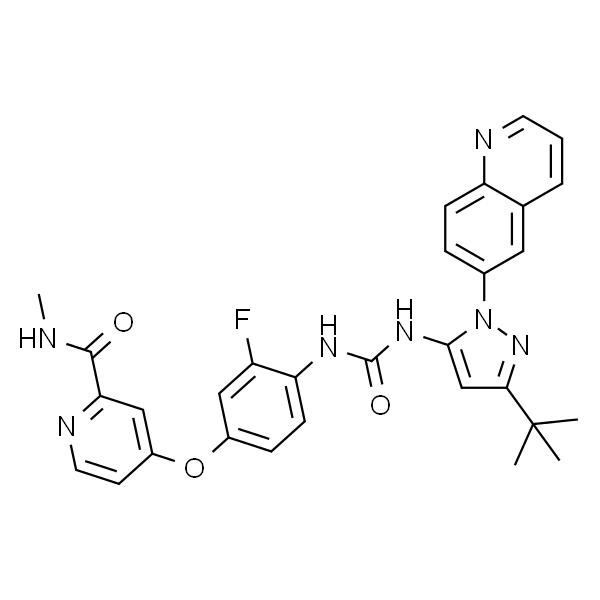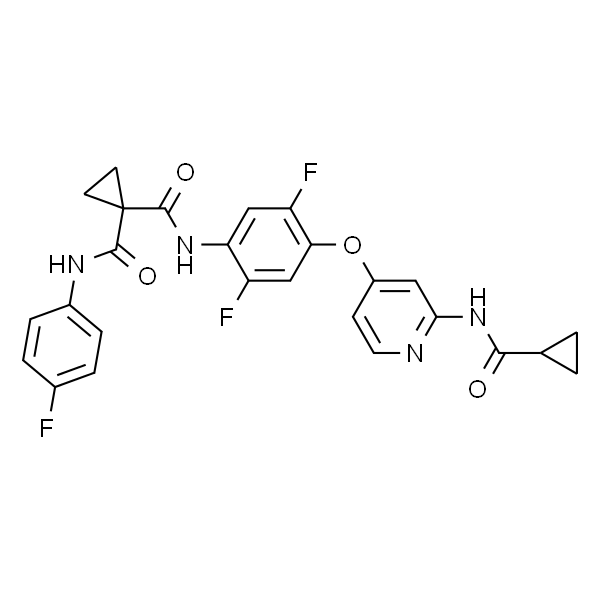Rebastinib
货号:
IR0640
品牌:
Jinpan

暂无详情
产品简介
| MDL | MFCD19443646 |
| 别名 | DCC-2036 |
| CAS | 1020172-07-9 |
| 分子式 | C30H28FN7O3 |
| 分子量 | 553.59 |
| 储存条件 | 2-8°C |
| 纯度 | Purity≥98% |
| 单位 | 瓶 |
| 生物活性 | Rebastinib (DCC-2036) 是一种 Bcr-Abl 抑制剂抑制剂,作用于 Abl1WT 和 Abl1T315I,IC50 分别为 0.8 nM 和 4 nM,也抑制SRC,KDR,FLT3 和 Tie-2,低活性作用于c-Kit。[1] |
| In Vitro | Rebastinib(DCC-2036)抑制ABL1native和网守突变体ABL1T315I,IC50分别为0.8 nM和4 nM。 Rebastinib有效(IC50 0.82 nM)抑制u-ABL1native,其被认为主要存在于无活性的II型构象中。此外,Rebastinib还强烈抑制p-ABL1native(IC50 2 nM),后者更容易采用活性的I型构象。更重要的是,Rebastinib有效抑制u-ABL1T315I(IC50 5 nM)和p-ABL1T315I(IC50 4 nM),由于T315I突变使活化的疏水性脊柱稳定,两者都主要以I型构象存在。 Rebastinib也有效抑制ABL1H396P(IC50 1.4 nM),与ABL1T315I一样,由于突变体Pro396强加的骨架扭转角受限,因此易于主要以I型激活构象存在。除ABL1外,Rebastinib还抑制SRC家族激酶LYN,SRC,FGR和HCK,PDGFRα和PDGFRβ,IC50为29±1,34±6,38±1,40±1,70±10和113分别为±10 nM。值得注意的是,Rebastinib保留了c-KIT(IC50 481 nM)。 Rebastinib有效抑制表达天然BCR-ABL1native的Ba / F3细胞的增殖(IC50 5.4nM)。 Rebastinib还抑制Ph +细胞系K562的增殖(IC50 5.5nM)。 REBASTINIB(DCC-2036)还抑制BCR-ABL1的几种常见TKI抗性突变体的增殖,包括G250E,Q252H,Y235F,E255K,V299L,F317L和M351T,IC50范围为6-150nM。 Rebastinib有效抑制BCR-ABL1native(IC50 29 nM)和BCR-ABL1T315I(IC50 18 nM)的自身磷酸化,以及两种细胞系中STAT5的磷酸化(IC50分别为28 nM和13 nM)[1]。 |
| In Vivo | 单次口服剂量的Rebastinib(DCC-2036)100 mg / kg可提供超过12μM的循环血浆水平长达24小时(数据未显示),并有效抑制BCR-ABL1信号传导长达8小时的Ba /从BM和携带荷瘤小鼠的脾分离的F3-BCR-ABL1T315I白血病细胞,通过磷酸-STAT5的细胞内流式细胞术染色和磷酸-BCR-ABL1和磷酸-STAT5的组织提取物的免疫印迹评估。用口服强饲法以100mg / kg每天一次用Rebastinib治疗携带Ba / F3-BCR-ABL1T315I白血病细胞的小鼠显著延长其存活,而每天两次100mg / kg的伊马替尼是无效的。在这种侵袭性的同种异体移植模型中,Rebastinib(DCC-2036)对治疗BCR-ABLT315I白血病同样有效,因为每天两次100 mg / kg的伊马替尼用于治疗BCR-ABL1native白血病,并减少白血病细胞在脾脏中的负担。治疗小鼠[1]。 |
| 激酶实验 | 来自患有复发和难治性Ph + B-ALL和可检测的T315I突变(等位基因频率40%)的患者的外周血原始细胞在补充有100μM2-巯基乙醇和0.5%BSA的IMDM中孵育过夜(初始细胞存活率> 90%),并且无药物或伊马替尼(1μM)或瑞巴斯替尼(DCC-2036)(50,200和1000 nM)。温育后,裂解细胞,并如上所述对蛋白质提取物进行免疫印迹分析。将患有慢性期CML和L298V突变的患者的外周血单核细胞(7.5×105)在不同浓度的Rebastinib(DCC-2036)或DMSO中孵育3小时,然后进行裂解和免疫印迹分析[1]。 |
| 靶点 | Bcr-Abl |
| 动物实验 | 小鼠[1]通过用BCR-ABL1native或BCR-ABL1T315I逆转录病毒转导而转化为白细胞介素-3独立性的Ba / F3细胞(1×106)被静脉内注射到同系Balb / c受体中。注射后第3天开始,给予小鼠伊马替尼(100 mg / kg水,每日两次,通过口服强饲)或瑞巴司他(DCC-2036)(100 mg / kg,0.5%CMC / 1%Tween-80,一次)每日通过口服强饲法)或仅用载体(0.5%CMC / 1%吐温-80)。为了诱导CML样白血病,静脉注射150mg / kg 5-氟尿嘧啶(5-FU),用BCR-ABL1T315I逆转录病毒转导后4天收获雄性Balb / c供体小鼠的骨髓(BM),和5×将105个细胞静脉内注射到经亚致死剂量照射的(400cGy)Balb / c受体中。从移植后第5天开始,通过单独载体或Rebastinib(DCC-2036)以100mg / kg口服强饲法每天一次治疗组群。对于B细胞急性淋巴细胞白血病的诱导,来自未用5-FU预处理的供体的BM用BCR-ABL1T315I逆转录病毒转导一次,并将1×106细胞注射到经亚致死照射的Balb / c受体中。从移植后第8天开始,每天通过口服管饲法单独使用载体,每天两次,使用Rebastinib(DCC-2036),60 mg / kg,伊马替尼100 mg / kg(水中),或达沙替尼10 mg / kg(在80mM柠檬酸pH 3.1中)。 |
| 细胞实验 | 将Ba / F3细胞(3×103细胞/孔)或原代Ph +白血病细胞(5×10 4细胞/孔)一式三份铺板于含有测试化合物(例如,Rebastinib(DCC-2036))的96孔板中。 72小时后,通过刃天青或MTT测定法定量活细胞。结果代表至少三次独立实验的平均值[1]。 |
| 数据来源文献 | [1]. Chan WW, et al. Conformational control inhibition of the BCR-ABL1 tyrosine kinase, including the gatekeeper T315I mutant, by the switch-control inhibitor DCC-2036. Cancer Cell. 2011, 19(4), 556-568 |
| 规格 | 5mg 10mg 50mg |
Rebastinib是一种Bcr-Abl抑制剂。

